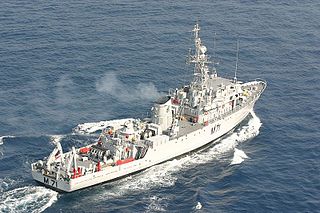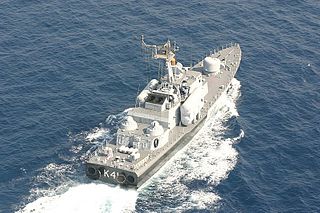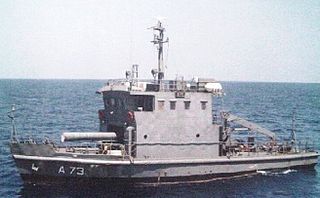
INSVikrant was a Majestic-class aircraft carrier of the Indian Navy. The ship was laid down as HMS Hercules for the British Royal Navy during World War II, but was put on hold when the war ended. India purchased the incomplete carrier in 1957, and construction was completed in 1961. Vikrant was commissioned as the first aircraft carrier of the Indian Navy and played a key role in enforcing the naval blockade of East Pakistan during the Indo-Pakistani War of 1971.

INS Viraat was a Centaur-class aircraft carrier of the Indian Navy. INS Viraat was the flagship of the Indian Navy until INS Vikramaditya was commissioned in 2013. The ship was completed and commissioned in 1959 as the Royal Navy's HMS Hermes, and decommissioned in 1984. It was sold to India in 1987. INS Viraat was commissioned into the Indian Navy on 12 May 1987, and served for almost 30 years.

The Rajput-class guided-missile destroyers built for the Indian Navy are modified versions of Soviet Kashin-class destroyers. They are also known as Kashin-II class. The ships were built in the former Soviet Union after considerable Indian design modifications to the Kashin design. These included the replacement of the helicopter pad in the original design with a flight elevator, as well as major changes to the electronics and combat systems. Five units were built for export to India in the 1980s. All units are currently attached to the Eastern Naval Command.

INS Vikramaditya is a modified Kiev-class aircraft carrier and the flagship of the Indian Navy. She entered into service in 2013.

The Godavari-class frigates were guided-missile frigates of the Indian Navy. The Godavari class was the first significant indigenous warship design and development initiative of the Indian Navy. Its design is a modification of the Nilgiri class with a focus on indigenous content of 72%, a larger hull and updated armaments. The class and the lead ship, INS Godavari were named after the Godavari River. Subsequent ships in the class, INS Ganga and INS Gomati also took their names from Indian rivers.

The Pondicherry class are a class of minesweepers built for the Indian Navy by the Soviet Union. They are modified versions of the Natya-class minesweeper. The vessels were acquired in two batches. The first were purchased from 1977 to 1980 and the second from 1986 to 1988. Technically, the second batch is referred to as the Karwar class but are physically identical to the first batch with the exception of additional surface-to-air missiles. As minesweepers, they are large and heavily armed. They can serve a dual purpose as an anti-submarine warfare escort. Their hulls are constructed of U3 low magnetic signature steel.

INS Godavari (F20) was the lead ship of her class of guided-missile frigates of the Indian Navy. Built by Mazagon Dock Limited in Mumbai, she was the first Indian warship to be indigenously designed and built. She was commissioned on 10 December 1983, and decommissioned on 23 December 2015 after a 32-year career.

The Abhay-class corvettes of the Indian Navy are the customised variants of the Soviet Pauk-class corvettes. The class was primarily intended for coastal patrol and anti-submarine warfare. Last ship of the class is expected to be decommissioned till 2025.

The Veer-class corvettes of the Indian Navy are a customised Indian variant of the Soviet Tarantul class. They form the 22nd Killer Missile Vessel Squadron.
INS Vela (S40) was the lead ship of four diesel-electric Vela-class submarines of the Indian Navy. The submarine was commissioned on 31 August 1973 in Riga, Latvian SSR. Along with her sister ship Vagli, she spent almost 10 years undergoing a protracted refit by Hindustan Shipyard. After 37 years of service, the submarine was decommissioned on 25 June 2010. The submarine was claimed by the Eastern Naval Command to be the oldest operational submarine in the world at the time of her decommissioning.

Kumbhir-class landing ships are medium amphibious warfare vessels of the Indian Navy.

The Sandhayak-class survey ships are a series of eight vessels built by Garden Reach Shipbuilders and Engineers (GRSE), Kolkata and Goa Shipyard, Ltd., Vasco for the Indian Navy. While Sandhayak, Investigator, Nirdeshak, Nirupak were built in GRSE; Sarveshak, Jamuna, Darshak, Sutlej were built by Goa Shipyard. The vessels equipped with four survey motor boats, two small boats and are powered by two diesel engines with a top speed of 16 knots. They have a helicopter deck and are also armed with a Bofors 40 mm/60 gun mount for self-defense.

The Astravahini class of torpedo recovery vessels are a series of naval auxiliary watercraft built by Goa Shipyard Limited and P.S. & Company for the Indian Navy. They are intended to recover practice torpedoes and mines, fired and laid by ships, submarines and aircraft. The vessels can stow two full-sized torpedoes on deck and two on a recovery ramp.
INS Batti Malv (T67) is the 3rd ship of the Bangaram-class patrol vessels of the Indian Navy, designed for interdiction against fast moving surface vessels and for search-and-rescue operations in coastal areas and in the exclusive economic zone. Named after the Battimalv Island in Nicobar, the vessel was designed and built by Garden Reach Shipbuilders and Engineers. The diesel generators on board are supplied by Cummins India. The electronic equipment on board including satellite communication and global positioning systems is from Bharat Electronics Limited, ECIL and Hindustan Aeronautics Limited.












